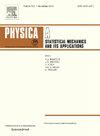Thermodynamic properties of high-dimensional Heisenberg ferromagnets with an arbitrary spin-S
IF 3.1
3区 物理与天体物理
Q2 PHYSICS, MULTIDISCIPLINARY
Physica A: Statistical Mechanics and its Applications
Pub Date : 2025-06-09
DOI:10.1016/j.physa.2025.130730
引用次数: 0
Abstract
This study extends the Heisenberg ferromagnetic model to high-dimensional simple hypercubic lattice systems by using the double-time Green’s function method. Analytical derivation and numerical calculation were performed on the lattice structural factor, Curie temperature, and spontaneous magnetization. It is found that the spontaneous magnetization of -dimensional () Heisenberg ferromagnet with an arbitrary spin- obeys the Td/2 law at very low temperatures. This indicates that the low-temperature magnetization characteristics are closely related to the spatial dimension. The lattice structural factor is evaluated for to 15. It is interesting to note that when the spatial dimension is very large, the Curie temperature is nearly proportional to the at any fixed spin-, which means that the Curie temperature increases with the with no upper limit. In addition, it is observed that the larger the spin-, the closer the normalized spontaneous magnetization versus the normalized temperature curves for different spatial dimension .
具有任意自旋s的高维海森堡铁磁体的热力学性质
本文利用双时间格林函数方法将海森堡铁磁模型推广到高维简单超立方晶格系统。对晶格结构因子、居里温度和自发磁化强度进行了解析推导和数值计算。发现任意自旋为s的d维(d≥3)海森堡铁磁体在极低温度下的自发磁化遵循Td/2定律。这表明低温磁化特性与空间维数密切相关。当d=3到15时,计算晶格结构因子。有趣的是,当空间维d很大时,在任意固定自旋s处,居里温度几乎与d成正比,这意味着居里温度随d的增加而增加,没有上限。此外,自旋s越大,不同空间维d下归一化自发磁化曲线与归一化温度曲线越接近。
本文章由计算机程序翻译,如有差异,请以英文原文为准。
求助全文
约1分钟内获得全文
求助全文
来源期刊
CiteScore
7.20
自引率
9.10%
发文量
852
审稿时长
6.6 months
期刊介绍:
Physica A: Statistical Mechanics and its Applications
Recognized by the European Physical Society
Physica A publishes research in the field of statistical mechanics and its applications.
Statistical mechanics sets out to explain the behaviour of macroscopic systems by studying the statistical properties of their microscopic constituents.
Applications of the techniques of statistical mechanics are widespread, and include: applications to physical systems such as solids, liquids and gases; applications to chemical and biological systems (colloids, interfaces, complex fluids, polymers and biopolymers, cell physics); and other interdisciplinary applications to for instance biological, economical and sociological systems.

 求助内容:
求助内容: 应助结果提醒方式:
应助结果提醒方式:


